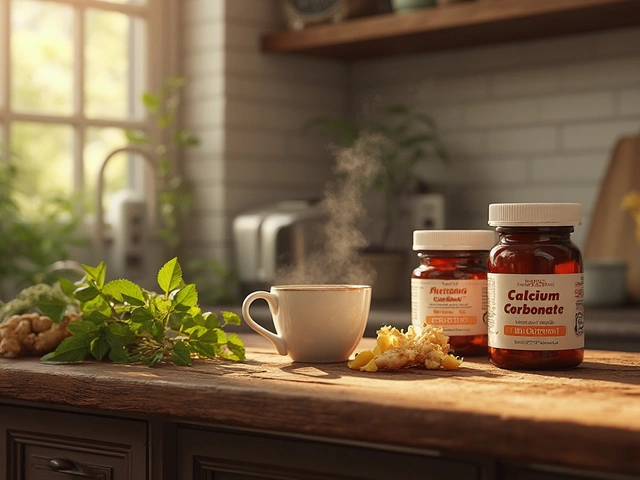2
Hound’s Tongue Supplement: Benefits, Risks, and Safe Alternatives (2025 Guide)

Here’s the blunt truth you came for: there are no proven health benefits to taking a hound's tongue supplement, and there’s a very real risk it can damage your liver. If you’ve heard buzz about Hound’s Tongue (Cynoglossum officinale) for pain, coughs, or “detox,” the science just doesn’t back it. What we do have is clear: this plant contains pyrrolizidine alkaloids (PAs)-compounds that are toxic to the liver and can also be carcinogenic. I’ll walk you through the claims, the evidence, the safety picture (with what Australia’s TGA and other regulators say), and the smart alternatives to reach the same goals without gambling with your health.
- TL;DR: No credible human evidence supports internal use of Hound’s Tongue for health; PAs in the plant can cause liver injury.
- Regulators in Australia, the EU, and the US flag PA-containing herbs as unsafe to ingest; internal use is restricted or discouraged.
- “PA-free” on a label means nothing unless there’s a current lab report (LC-MS/LC-MS-MS) showing non-detectable levels.
- If you’re after anti-inflammatory, cough, or wound-support effects, safer and better-studied options exist.
What people claim Hound’s Tongue can do vs what the science actually shows
Hound’s Tongue is a weedy herb in the borage family. You might see claims that it soothes coughs, calms pain, heals wounds, eases spasms, or “detoxes” the body. These ideas trace back to old European folk uses and the fact that related plants (like comfrey) were used externally for sprains and bruises. None of that is solid clinical evidence for swallowing the stuff.
Let’s separate story from data. The plant contains a class of compounds called 1,2-unsaturated pyrrolizidine alkaloids (PAs)-including intermedine, lycopsamine, echimidine, and heliosupine. These are pro-toxins: your liver converts them into reactive metabolites that can scar small liver veins (veno-occlusive disease, also called sinusoidal obstruction syndrome) and potentially increase cancer risk with chronic exposure. This isn’t hypothetical; it’s well documented in toxicology and case reports.
What about benefits? There are no randomized controlled trials in humans showing that ingesting Hound’s Tongue helps pain, cough, ulcers, skin issues, or anything else. Notes of “antibacterial” or “anti-inflammatory” activity you might see online are typically from test-tube assays or low-quality animal data that don’t translate to safe, effective dosing in humans. When there are zero credible trials and a known mechanism of harm, that’s not a supplement-it’s a risk.
Now, the safety part. Authoritative bodies have taken a clear stance on PAs:
- World Health Organization monographs and poison center reports describe PA-induced liver injury and veno-occlusive disease from contaminated teas, honey, and traditional remedies.
- EFSA (European Food Safety Authority) classifies 1,2-unsaturated PAs as genotoxic and carcinogenic. They advise keeping dietary exposure as low as reasonably achievable; several EU countries set strict limits in foods and supplements.
- Australia’s TGA regulates PA-containing herbs tightly; internal use of PA-bearing botanicals is restricted, and listed medicines must comply with very stringent PA limits. Many PA-containing plants are effectively limited to external preparations, if allowed at all.
- US safety resources (including toxicology databases and poison control centers) warn against ingesting PA-containing herbs such as comfrey-and Hound’s Tongue is in the same risk basket.
Topical? Even that is not a free pass. PAs can absorb through the skin, especially on broken or inflamed skin, and repeated use raises exposure. That’s why several regulators discourage topical use or confine it to very short-term, intact-skin products with verified low or non-detectable PA levels.
Here’s a quick evidence map to keep handy:
| Claimed use | Human evidence | Main risk | Regulatory stance (AU/EU/US) | Safer alternative to try |
|---|---|---|---|---|
| Cough/bronchitis | No clinical trials | Liver injury from PAs | Internal use restricted/discouraged | Ivy leaf extract (Hedera helix), thyme-ivy combo; honey for adults |
| Pain/inflammation | No clinical trials | Genotoxic, hepatotoxic | Limits in place for PA exposure | Turmeric/curcumin; ginger; boswellia; topical diclofenac (OTC) |
| Wound healing (topical) | No robust trials; PA absorption risk | Systemic PA absorption via skin | Topical use often discouraged or strictly limited | Medical-grade manuka honey; silicone gel; clean dressings |
| “Detox” / liver support | No evidence; opposite effect likely | Direct liver toxicity | Warnings across jurisdictions | Milk thistle (silymarin) with caution; lifestyle liver care |
| Antibacterial/antiviral | In vitro only; not clinically meaningful | Harm outweighs lab signals | Not permitted as internal PA source | Standard care; evidence-based herbals for specific cases |
Bottom line for this section: marketing copy leans on tradition and lab petri dishes; the medical literature highlights liver injuries and regulatory red flags. When those two collide, your best move is to walk away.

How to make a safe call: decision path, label checks, and proven alternatives
If you clicked in hoping to “discover amazing benefits,” I get it. Here’s a practical way to decide what to do next without losing time-or liver cells.
- Define the job you want done. Are you trying to quiet a cough, ease joint pain, calm muscle spasm, or speed up a bruise?
- Check whether Hound’s Tongue has human data for that job. It doesn’t.
- Ask if the harm profile outweighs theoretical benefits. With PAs, yes.
- Switch to a safer, studied option that matches the job.
- If you already took Hound’s Tongue, read the “What if I’ve already used it?” section below.
Before we hit alternatives, a quick myth-busting list:
- “A tiny dose is safe.” Not reliably. PA toxicity can be cumulative and varies by product, harvest, and extraction. You can’t eyeball a safe dose.
- “PA-free extraction makes it fine.” Only if a recent, independent lab report shows non-detectable 1,2-unsaturated PAs using a modern method (LC-MS/MS) and batch numbers match your bottle. Most products won’t show this.
- “Topical is harmless.” Repeated or broken-skin use can still deliver PAs. Many regulators restrict even external use.
- “It’s natural, so safer than meds.” Nature makes poison too. Ricin is natural; so is nicotine. Risk is about chemistry, not vibe.
Label checks if you encounter any PA-risk herb (comfrey, Heliotropium, Senecio, Echium, and yes, Cynoglossum/Hound’s Tongue):
- Botanical identity: must list Cynoglossum officinale L., part used, and extraction ratio/solvent.
- PA statement: look for “tested for 1,2-unsaturated pyrrolizidine alkaloids.” If absent, treat as untested.
- COA availability: current batch Certificate of Analysis with specific PA analytes and results below method LOQ. If they won’t share it, skip.
- Regulatory status (Australia): does the label carry an AUST L or AUST L(A) number? If not, it’s not a TGA-listed medicine.
- Red flags: “proprietary blend,” miracle claims, detox promises, no manufacturer address, or foreign-language-only inserts.
Now, here are safer, evidence-backed options mapped to common “jobs” people chase with Hound’s Tongue claims. Use these as conversation starters with your GP or pharmacist.
For cough and chest congestion:
- Ivy leaf extract (Hedera helix): standardized products have randomized trials showing improved mucus clearance and cough intensity in acute bronchitis in adults and children (always check age labeling).
- Thyme-ivy or thyme-primrose combinations: clinical evidence supports modest symptom relief in uncomplicated bronchitis.
- Honey (adults and children over 1 year): comparative studies suggest it can reduce cough frequency at night; avoid in infants under 1 due to botulism risk.
For joint pain, muscle aches, and inflammation:
- Turmeric/curcumin: multiple controlled trials show benefit for knee osteoarthritis pain; choose a formulation with proven bioavailability; watch interactions with anticoagulants.
- Ginger: doses equivalent to 1-2 g/day of dried rhizome can help dysmenorrhea and osteoarthritis pain in trials; also supports nausea relief.
- Boswellia serrata (AKBA-standardized): clinical data supports improved pain and function in osteoarthritis; check for standardized content.
- Topical diclofenac gel (OTC in many countries): strong evidence for local musculoskeletal pain with a lower systemic side effect profile than oral NSAIDs.
For wound care and bruises (external only):
- Medical-grade manuka honey dressings: approved wound products with antimicrobial activity and moisture balance; used in clinics across Australia and worldwide.
- Silicone gel/sheets: reduce hypertrophic scars and keloids when used consistently.
- Arnica topical: some evidence for bruising, but avoid broken skin; pick products from reputable manufacturers and watch for sensitivity.
For “liver support” and general detox vibes:
- Milk thistle (silymarin): mixed but generally safe evidence for liver enzyme improvements in some contexts; ensure a reputable brand; discuss with your GP if you have liver disease or take medications.
- Lifestyle levers: stay under the Australian alcohol guidelines, maintain a healthy weight, manage metabolic risk, get vaccinated for hepatitis if indicated, and keep paracetamol within recommended doses.
A quick safety heuristic you can use for any herbal product, not just Hound’s Tongue:
- Does the plant have a known toxic class (like PAs, aristolochic acids, cardiac glycosides)? If yes, assume risk unless proven otherwise.
- Is there at least one decent human trial for your goal? If no, don’t be the experiment.
- Is there a batch-matched COA that answers the main risk (e.g., PA levels)? If no, pass.
- Is there a safer, studied alternative? If yes, use that first.
If you’re in Australia, a quick word on the TGA: listed medicines carry an AUST L number and must meet safety and quality standards; AUST L(A) products have had some evidence assessed for claims. This doesn’t mean “proven” like a prescription drug, but it’s far better than an anonymous online bottle. For something like Hound’s Tongue, you’re unlikely to find a compliant TGA-listed internal product due to the PA issue.

FAQ, red flags, and what to do if you’ve already taken it
Is Hound’s Tongue the same as comfrey? No, but they’re both in the borage family and both produce the same type of 1,2-unsaturated PAs that damage the liver. Regulators treat them similarly for internal use: avoid.
Can PAs be “removed” to make Hound’s Tongue safe? In theory, certain extraction methods can reduce PA content, but consistency is the problem. Without a recent, batch-specific lab report showing non-detectable PAs with a sensitive method, you’re guessing. Most products won’t provide this-and even if they do, robust clinical benefit data is absent.
Is there a safe dose? There’s no dose that’s both proven effective and proven safe long-term for ingestion. Toxicologists use a “margin of exposure” approach for PAs because they’re genotoxic; the guidance is to keep exposure as low as reasonably achievable.
Is topical use fine? Not automatically. Repeated use, large areas, or broken skin can increase absorption. If you’re set on topical botanicals, pick options without PA risk and from brands that publish contaminant testing.
Who should absolutely avoid PA-risk herbs? Children, pregnant or breastfeeding people, anyone with liver disease, those on hepatotoxic medications (like high-dose paracetamol, certain TB or cancer drugs), heavy alcohol users, and anyone scheduled for major surgery.
What signs suggest liver stress? Watch for unusual fatigue, right-upper abdominal pain, dark urine, pale stools, itchy skin, yellowing of the eyes/skin, nausea, poor appetite, or easy bruising. If these appear after taking any herbal product, stop it and speak to a healthcare professional promptly. A simple blood test (ALT, AST, bilirubin, ALP) can check liver function.
Will this interact with my medications? PA-containing products don’t have clean “interactions” in the usual sense-they’re directly toxic. But the risk stacks with anything stressing the liver (alcohol, paracetamol overuse, methotrexate, isoniazid). If you’re on anticoagulants, chemotherapy, antiepileptics, or statins, you owe it to yourself to keep new supplements simple and well-studied.
Is it legal to sell? Rules vary, but many jurisdictions restrict internal use of PA-producing herbs and set very low limits for PA contamination in any herbal product. In Australia, the TGA framework means you’re unlikely to see a compliant internal Hound’s Tongue supplement. In the EU, limits on PAs in teas, honey, and supplements are increasingly strict. In the US, while supplements face looser premarket control, manufacturers are still responsible for safety-PA-positive products have been subject to warnings and recalls.
What if I’ve already used it? Here’s a calm, step-by-step plan:
- Stop the product now. Keep the bottle, label, and any receipts.
- Note your symptoms, if any, with dates. Even vague fatigue matters.
- Book a chat with your GP or pharmacist; ask whether a liver panel (ALT, AST, ALP, bilirubin) makes sense for you.
- Hydrate, avoid alcohol, and skip other non-essential supplements for a bit.
- Report suspected adverse effects to your national regulator (in Australia, the TGA adverse event portal; in the US, FDA MedWatch). Reporting helps others.
Still tempted by a bottle labeled “PA-free Hound’s Tongue”? If you won’t be dissuaded, at least follow a strict vetting checklist:
- Demand a batch-matched COA from an independent lab with LC-MS/MS data listing specific PAs (intermedine, lycopsamine, echimidine, heliosupine, and their N-oxides).
- Check a recent production date and that the COA’s lot number matches your bottle.
- Confirm the product has a local regulatory identifier (AUST L/AUST L(A) in Australia). Absence is a red flag.
- Avoid multi-herb “detox” blends. They hide dosing and risks.
- If any doubt remains, choose a safer alternative and move on.
If you came hoping to discover “amazing health benefits,” the discovery is this: the smart benefit is knowing when not to take a thing. Hound’s Tongue looks interesting in old herbals, but modern safety science says it doesn’t belong in your daily stack. You can reach your goals-less pain, calmer cough, cleaner wound healing-using options with actual human data and far less downside.
Next steps you can take today:
- Pick one evidence-backed alternative that matches your goal (ivy leaf for cough; turmeric or ginger for joint pain; medical-grade honey for wound care).
- Choose a reputable brand: look for standardization, batch COAs, and-for Aussies-an AUST L or AUST L(A) number.
- Run it past your GP or pharmacist, especially if you take prescription meds or have a health condition.
- Set a clear trial period (e.g., 4-8 weeks), track symptoms, and stop if you don’t see benefit.
I write this from Sydney with a simple bias: I want you to get the result you’re chasing without taking a hidden hit. In 2025, with what we know about PA chemistry and liver risk, Hound’s Tongue as a dietary supplement isn’t a savvy play. Better choices exist. Take them.









Todd Peeples
September 5, 2025 AT 21:14In the epistemological framework of phytotherapy, the ontological status of Cynoglossum officinale warrants a rigorous interrogation of its pharmacodynamic profile, particularly given the presence of 1,2‑unsaturated pyrrolizidine alkaloids (PAs) which exhibit hepatotoxic and genotoxic potential. The biochemical cascade initiated by hepatic cytochrome P450 oxidation of these alkaloids culminates in the formation of reactive pyrrole metabolites that covalently bind to nucleic acids, thereby precipitating sinusoidal obstruction syndrome and an elevated carcinogenic risk. Contemporary toxicological surveillance, as articulated by the World Health Organization and corroborated by the European Food Safety Authority, delineates a conservative margin of exposure that underscores the implausibility of a safe oral dosage regimen. Regulatory agencies across the United States, European Union, and Australia have instituted statutory limits that effectively preclude the commercialization of internal Hound’s Tongue supplements absent exhaustive analytical verification via LC‑MS/MS. Empirical evidence from randomized controlled trials is conspicuously absent, rendering any purported therapeutic benefit anecdotal at best. Consequently, a risk–benefit analysis predicated on current scientific data inevitably tilts towards contraindication. In lieu of speculative phytochemical optimism, practitioners should prioritize evidence‑based interventions such as standardized Hedera helix extracts for antitussive effects, curcumin formulations with established bioavailability for inflammatory modulation, and medical‑grade manuka honey for wound management. The heuristic of “if it sounds too good to be true, it probably is” remains a steadfast axiom in the realm of herbal supplement appraisal. Thus, clinicians and consumers alike are advised to eschew Hound’s Tongue ingestion and to allocate resources toward therapeutics substantiated by peer‑reviewed clinical outcomes. 😊
Chris Smith
September 8, 2025 AT 18:41Oh great another miracle herb – because the internet needed more snake oil, right?
Leonard Greenhall
September 11, 2025 AT 16:08The chemical profile of Cynoglossum officinale includes pyrrolizidine alkaloids, which are well‑documented hepatotoxins. Regulatory agencies have explicitly flagged these compounds as unsafe for ingestion. No peer‑reviewed clinical trials demonstrate efficacy for the claimed uses. Therefore, the risk outweighs any theoretical benefit.
Abigail Brown
September 14, 2025 AT 13:34Reading this feels like watching a drama where the villain is a harmless‑looking plant that turns out to be a silent assassin for your liver. It’s amazing how centuries of folk lore can be so romanticized when the science tells us a very different story. Your body deserves better than a risky gamble, and there are plenty of proven herbs that actually work without the shadow of toxicity. Let’s celebrate the options that have real data behind them – they’re the true heroes in our health journeys! 🌟
Crystal Slininger
September 17, 2025 AT 11:01People think they’re hiding the truth about Hound’s Tongue, but the labs are out there publishing data every week. The PA levels are measured in micrograms per kilogram, and even tiny amounts can accumulate over time. If you’re buying a bottle that claims “PA‑free,” demand the batch‑specific LC‑MS report – otherwise you’re just buying a placebo wrapped in conspiracy hype.
Sumeet Kumar
September 20, 2025 AT 08:28Hey folks, just a friendly reminder to stay safe and choose supplements that have clear testing. 🛡️ If you see a product without a COA, it’s better to skip it. Your liver will thank you!
Maribeth Cory
September 23, 2025 AT 05:54Let’s be clear: opting for well‑studied alternatives like turmeric or ginger is a proactive step. I’m not here to tell you what to do, but I strongly suggest you prioritize safety over unproven claims. It’s a matter of responsible health stewardship.
andrea mascarenas
September 26, 2025 AT 03:21For anyone looking at a supplement label, check that the ingredient list includes the botanical name and the part used. If it’s missing, that’s a red flag.
Vince D
September 29, 2025 AT 00:48Skip Hound’s Tongue, pick proven herbs.
Camille Ramsey
October 1, 2025 AT 22:14This is totally bs, u cant trust any of those herbal stuff. Its all a con and ppl get sick. Stop belivin the hype!!!
Scott Swanson
October 4, 2025 AT 19:41Honestly, if you’re looking for a “detox” miracle, you’re better off drinking water and getting a good night’s sleep. The market is flooded with hyped‑up blends that do nothing but waste your money.
Karen Gizelle
October 7, 2025 AT 17:08Wow, another perfect example of folks believing in fairy‑tale cures. Real science says no, so stop the nonsense.
Stephanie Watkins
October 10, 2025 AT 14:34Could you point out where the evidence for safety is missing? I’m curious about the specific studies that were referenced in the post.
Zachary Endres
October 13, 2025 AT 12:01Imagine the relief of finally ditching a harmful supplement and embracing a proven remedy – it’s like stepping into the light after a long, cloudy night. Let’s champion informed choices together!
Ashley Stauber
October 16, 2025 AT 09:28Everyone’s acting like this plant is a monster, but why not just trust traditional uses? People have used it for ages, so it can’t be that bad.
Amy Elder
October 19, 2025 AT 06:54Just a heads‑up: many “detox” products have hidden PA levels. Keep an eye on the label and stay safe.
Erin Devlin
October 22, 2025 AT 04:21Herbal supplements should be evaluated with the same rigor as pharmaceuticals; otherwise, we risk repeating past mistakes.
Will Esguerra
October 25, 2025 AT 01:48From a toxicological standpoint, the presence of pyrrolizidine alkaloids in Cynoglossum officinale is not a trivial concern; these compounds possess a well‑documented capacity for irreversible hepatic injury and possess genotoxic properties that may incite carcinogenesis over prolonged exposure. The cumulative nature of PA toxicity, even at sub‑lethal doses, necessitates an extreme precautionary approach. Consequently, the prudent course of action is to eschew internal consumption of any preparation lacking definitive analytical confirmation of PA absence. This is not merely a recommendation but a safeguard against insidious, long‑term health detriment. 🛑
Allison Marruffo
October 27, 2025 AT 23:14For anyone weighing options, choose supplements with transparent testing, reputable manufacturers, and clear regulatory compliance. That’s the best way to protect your health.